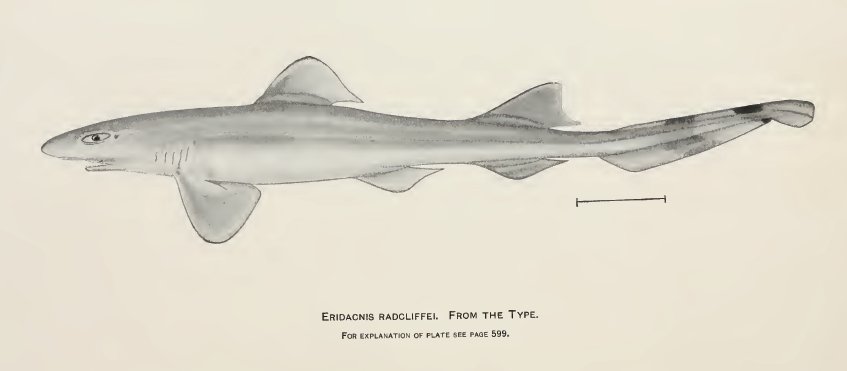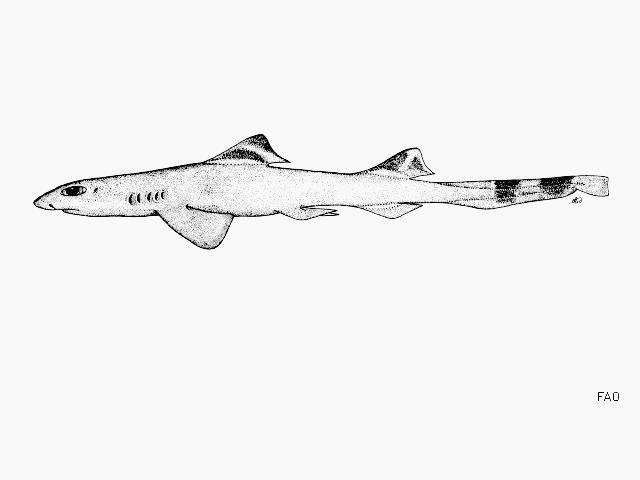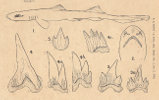Eridacnis radcliffei
Smith, 1913
Pygmy ribbontail catshark
Classification: Elasmobranchii Carcharhiniformes Proscylliidae
Reference of the original description
Description of a new carcharioid shark from the Sulu Archipelago. Proceedings of the United States National Museum, 45, 599–600
Description of a new carcharioid shark from the Sulu Archipelago. Proceedings of the United States National Museum, 45, 599–600
Image of the original description

Eridacnis radcliffei Smith, 1913

Eridacnis radcliffei Smith, 1913
Synonyms / new combinations and misspellings
Eridacnis cf. radcliffei, Eridacnis radcliffi, Proscyllium alcocki
Eridacnis cf. radcliffei, Eridacnis radcliffi, Proscyllium alcocki
Types
Eridacnis radcliffei
Holotype: USNM: 74604; Paratype: USNM: 317570;
Proscyllium alcocki
Holotype: ZSI: F229/1; Paratype: ZSI: F382/1;
Eridacnis radcliffei
Holotype: USNM: 74604; Paratype: USNM: 317570;
Proscyllium alcocki
Holotype: ZSI: F229/1; Paratype: ZSI: F382/1;
Description :
Citation: Eridacnis radcliffei Smith, 1913: In: Database of modern sharks, rays and chimaeras, www.shark-references.com, World Wide Web electronic publication, Version 01/2026
Please send your images of "Eridacnis radcliffei" to info@shark-references.com

Eridacnis radcliffei Smith, 1913, © FAO, www.fish-base.org

Eridacnis radcliffei Smith, 1913, © FAO, www.fish-base.org
Common names
 Tollo coludo pigmeo,
Tollo coludo pigmeo,  Requin chat pygmée,
Requin chat pygmée,  Requin-chat pygmé,
Requin-chat pygmé,  Pygmy ribbontail cat shark,
Pygmy ribbontail cat shark,  Pygmy ribbontail catshark
Pygmy ribbontail catshark
 Tollo coludo pigmeo,
Tollo coludo pigmeo,  Requin chat pygmée,
Requin chat pygmée,  Requin-chat pygmé,
Requin-chat pygmé,  Pygmy ribbontail cat shark,
Pygmy ribbontail cat shark,  Pygmy ribbontail catshark
Pygmy ribbontail catshark
Short Description
Caudal fin without a rippled dorsal margin and ventral lobe but with a strong subterminal notch; vertebral axis of caudal fin little raised above body axis [544]. Dark brown with blackish markings on dorsal fins [544].
Caudal fin without a rippled dorsal margin and ventral lobe but with a strong subterminal notch; vertebral axis of caudal fin little raised above body axis [544]. Dark brown with blackish markings on dorsal fins [544].
Distribution
Indo-West Pacific: widely distributed but with spotty records from Tanzania, the Gulf of Aden, India (Gulf of Mannar, Bay of Bengal), Andaman Islands, Viet Nam, and the Philippines. The immense range of this species is striking compared to the limited ranges of other members of the genus. Source: www.gbif.org
Indo-West Pacific: widely distributed but with spotty records from Tanzania, the Gulf of Aden, India (Gulf of Mannar, Bay of Bengal), Andaman Islands, Viet Nam, and the Philippines. The immense range of this species is striking compared to the limited ranges of other members of the genus. Source: www.gbif.org
Biology
Ovoviviparous, embryos feed solely on yolk [733]. 1-2 pups per litter, size at birth about 11 cm [517]. Feed (database 484 individuals): primarily crustaceans (74,2%, mostly Aristeus spp., Ophlophorus spp., P. quasigrandis and Heterocarpus spp), fish remains (23,4%) [16508];
Ovoviviparous, embryos feed solely on yolk [733]. 1-2 pups per litter, size at birth about 11 cm [517]. Feed (database 484 individuals): primarily crustaceans (74,2%, mostly Aristeus spp., Ophlophorus spp., P. quasigrandis and Heterocarpus spp), fish remains (23,4%) [16508];
Remarks
shark-references Species-ID=2148;
shark-references Species-ID=2148;

















